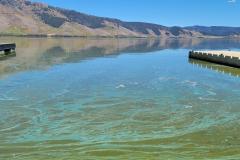The Division of Public Health in the Department of Health and Welfare has issued a health advisory for Henrys Lake in Fremont County.
The Idaho Department of Environmental Quality (DEQ) tested samples collected along the shoreline of Henrys Lake and confirmed the presence of the cyanobacteria species Microcystis, Dolichospermum, and Aphanizomenon. They all can produce dangerous toxins that can be harmful to people, pets, and livestock. Those with liver or kidney damage are at an increased risk of illness.

The division urges visitors to Henrys Lake to use caution when recreating in or near the water and take the following precautions while the advisory is in effect:
- Avoid swimming, wading, or other activities in the water.
- Take extra precautions to ensure children, pets, and livestock are not exposed to the water.
- Clean skin or pet fur with clean water as soon as possible after any water contact.
- Do not drink or cook with water containing a bloom. Boiling and filtering the water does not remove the toxins and can increase the risk of adverse health effects.
- Wash hands thoroughly in clean water after handling fish caught in water experiencing a bloom.
- Clean and wash fish thoroughly in uncontaminated water and dispose of internal organs before consumption. If you choose to eat fish from this area, filet the fish and remove all fat, skin, and organs before cooking. Cyanotoxins can accumulate in fish and the risk to people is still being studied.
Symptoms of cyanotoxin exposure include rash, hives, diarrhea, vomiting, coughing, and/or wheezing. More severe symptoms affecting the liver and nervous system may happen if the water is ingested. If symptoms persist, consult your healthcare provider.
Pets, livestock, and wildlife can get sick, or even die, within minutes to days after cyanotoxin exposure. Dogs are often the first affected because they are more likely to swim in or drink contaminated water or lick contaminated water or bloom material off their fur. If your pets or livestock have been in the water, immediately wash them with clean water to keep them from licking cyanobacteria off their bodies. Seek veterinary care immediately if your pets or livestock seem sick after going in or drinking the water.
Cyanobacteria are a natural part of Idaho’s water bodies. When temperatures rise, their populations can bloom and toxic chemical compounds, or cyanotoxins, can be released into the water. Blooms can vary in appearance, and may look like mats, foam, spilled paint, or surface scum, and have a foul odor. The Division works closely with DEQ and the public health districts in identifying, responding to, and monitoring cyanobacteria harmful algal blooms (HABS).
For more information about harmful algal blooms, visit DEQ’s website at https://www.deq.idaho.gov/water-quality/surface-water/cyanobacteria-harmful-algal-blooms/ or DHW’s website at https://www.gethealthy.dhw.idaho.gov/recreational-water-health-advisories.
- DEQ media contact: Anna Marron, 208-373-0427, Anna.Marron@deq.idaho.gov
- DEQ area contact: Destiny Locke, 208-528-2650, destiny.locke@deq.idaho.gov
- DHW: Niki Forbing-Orr, 208-334-0668, niki.forbing-orr@dhw.idaho.gov
Original source can be found here.



 Alerts Sign-up
Alerts Sign-up